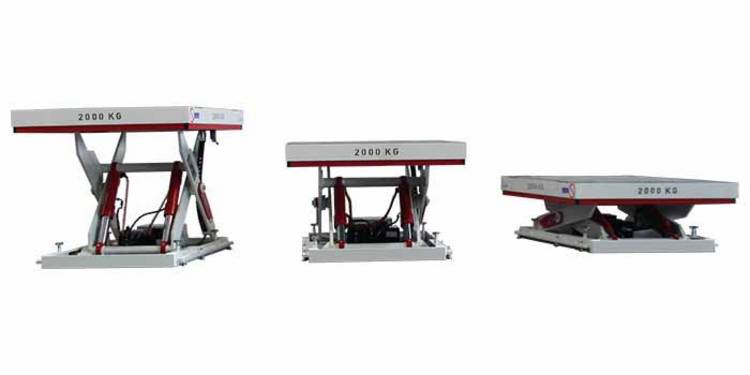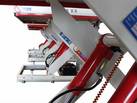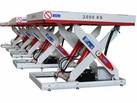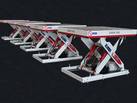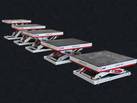These lift tables are used in prototype construction for ATMs. Great importance was attached to the issue of safety for people and machines when they were purchased. Read more about our measures here ...
Protection of electronic components
The safety factor must be given sufficient consideration with every lift table. However, it is not always enough to consider only the person using the lifting equipment. The load also requires special attention from time to time.
In this case, prototypes for ATMs are produced on the scissor lift table. The prototype workshop is set up to simulate the real conditions in actual production as closely as possible.
So, prototypes are not only developed and built, but the entire production process of the machines is reproduced as faithfully as possible.
As is well known, these machines combine high weight with sensitive electronic components. The biggest enemy of electronic components are voltage peaks, which can be caused by static electricity, for example. We have therefore taken two measures to exclude potential danger to the components:
Earthing of all components
All components of the lift table are mutually earthed. This prevents friction from creating static static electricity that deviates from the earth potential. This means that a voltage spike is not possible.
ESD rubber mat on the lift table
The platform is fitted with a rubber mat to protect the load on the lift table against mechanical damage. However, if a normal rubber mat were used in this case, the problem of inadequate earthing of the ATMs would again be a factor.
For this reason, an ESD rubber mat was vulcanised onto the lift table.
What is special about this is that this rubber mat is electrically conductive and therefore the load is earthed via the rubber mat and the lift table and the risk of voltage spikes is eliminated.
Safety for bystanders
It goes without saying that safety is an aspect that should not be neglected in any lift table. But these lift tables in particular had many special features that had to be taken into account:
Protruding loads
The frames to be lifted are larger than the actual lift table platform. This is necessary so that the frames can be transported over the existing rail system.
The problem here is that an employee can get his foot caught between the frames and the surrounding floor. Due to the high load of up to 2,000 kg this poses a serious risk of injury. For this reason we have taken two independent measures:
Stopping the lift table to prevent the risk of crushing
A freely adjustable intermediate stop switch has been installed on the lift table. If an employee presses the lowering button on the lift table, it lowers until just before the hazardous situation.
Now the operator must release the lowering button and press it again to lower the lift table completely. This is to make the employee aware of the possible danger. The idea is that the employee must check the hazard area again when the scissor lift stops, and only then may the lift table be completely lowered into the pit.
Super-flat safety edges outside the lift table
People make mistakes. If possible, the issue of safety should therefore not be made solely dependent on the correct behaviour of employees. Super-flat safety edges were installed around the lift table (height: approx. 10 mm) to completely rule out any risk.
If an employee steps with his foot into the hazard zone, the safety edges stop the lowering movement of the lift table. It can only be lowered further once the foot has been removed from the hazard zone.
The combination of these two measures ensures almost 100% safety for the feet of bystanders.
Off-centre loading of the lift table
The specified nominal load always applies to a load placed in the centre of the platform. Off-centre loads reduces the working load limit (WLL).
In this case, they wanted to make sure that the lift tables were always loaded in the middle. So, two inductive sensors were installed on the platform for this purpose. They switch against the metallic edge of the attached frame and therefore only allow a lifting movement when the load is placed in the centre of the lift table.
Electric shut-off valves
Leaks are always another risk in hydraulic systems. To prevent the platform from dropping uncontrollably, the cylinders of our lift tables and column lifts are equipped with Pipe rupture safety valves.
They stop the platform during a pipe break or hose rupture and so effectively prevent the platform from dropping uncontrollably.
However, if there is only a small leak in the hydraulic system, this safety measure fails. It does not detect the fault and the platform slowly starts to lower. As this source of danger should be avoided at all costs, we have used electrically pilot-operated hydraulic valves on the cylinder in this case. The lift table can only be lowered when the lowering button is pressed. This makes it irrelevant whether there is a leak or some similar problem.
For more information on the advantages and disadvantages of the various safety valves, please refer to the article: Safety through hydraulic valves.
Faster in production
The production lines needed to be ready for operation again as quickly as possible, so great importance was attached to a solution that would enable quick commissioning.
The following steps are followed when a lift table is installed in a pit in the usual manner:
- A hole is cut into the existing concrete slab.
- The area under the concrete slab is excavated.
- The new pit is shuttered.
- The shuttering is filled with concrete.
- A four-week wait follows until the concrete is fully cured.
The four-week waiting period was not acceptable in this case. We therefore offered a different solution. The lift table was delivered ready to use in a metal trough. The trough is fitted with stiffeners so that it is self-supporting and able to absorb all the loads from the lift table.
This procedure made it possible to shorten the process as follows:
- Cut a hole in the existing concrete ceiling.
- Insert lift table with pit trough and align it using the levelling screws.
- Cast with non-swelling, fast-binding resin.
- Commissioning of the lift table.
This shows that a resumption of production can be significantly accelerated by the use of the metallic pit trough.
Portable pendant control with signal lamp
The controller used here has two special features compared to our standard version. On the one hand, a portable pendant control was used, which hangs down from the customer's ceiling. This was an easy solution to the problem of the controller lying around.
The portable pendant control also has a signal lamp which shows that the lift table is completely retracted. Because the load is larger than the lift table, it would otherwise not be possible to see whether the platform of the lift table is already completely retracted and whether the frame can be pushed away.

